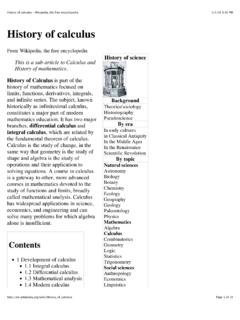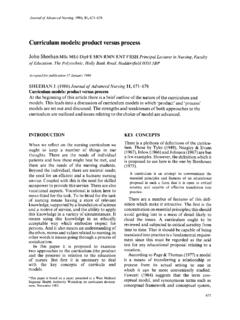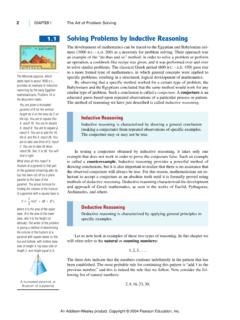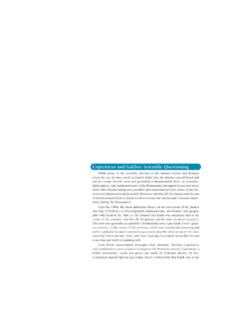Transcription of FUNdaMENTALS of Design
1 1/1/2008 2008 Alexander Slocum4-0 FUNdaMENTALSofDesignTopic 4 LinkagesLinkagesLinkages are perhaps the most fundamental class of machines that humans employ to turn thought into action. From the first lever and fulcrum, to the most complex shutter mechanism, linkages translate one type of motion into another. It is probably impossible to trace the true origin of linkages, for engineers have always been bad at documentation. Images of levers drawn in egyptian tombs may themselves be document-ing ancient (to them!) history. But given their useful-ness, linkages will be with us always. They form a link to our past and extend an arm to our future. As long as we keep turning the technological crank, they will cou-ple our efforts together so all followers of technology can move in you read this chapter on linkages, it is impor-tant to realize that history plays a vital role in the devel-opment of your own personal attitude towards becoming competent at creating and using linkages.
2 As it was with many other areas of engineering, applied mathema-ticians and their curiosity for how their new analysis tools could be used to understand problems (opportuni-ties!) catalyzed the discovery of linkages and analysis methods. The study of linkages is a very mature and rich subject area but it is by no means over. On the con-trary, entire courses are dedicated to teaching students how to master what is and is not known about the Design of linkages. Perhaps what is not known is just waiting for someone like you to make the next discovery! In particular, most of us are confined to using simple four or six bar linkages that move in a plane, but the world is three dimensional and waiting for you!1 Fortunately, for us mere mortal linkage designers, there is powerful linkage Design software that seem-lessly links to many solid modelling programs.
3 Just lkike snowboarding, you have to learn on the bunny slope before you ride extreme slopes, and you must learn the basics of linkage Design before you attempt to zoom from the top! Accordingly, this chapter will focus on the FUNdaMENTALS of linkage Design : physics, synthe-sis and robust Design & awesome book containing many great mechanism ideas is N. Sclater and N. Chironis, Mecha-nisms and Mechanical Devices, McGraw-Hill, New York, the Design of machines is of real interest, you should take a course on the Design of mechanisms where the entire focus of the course would be on the details of designing many different types of mecha-nisms from linkages to gear trains. An excellent reference is A. Erdman, G. Sandor, S.
4 Kota, Mechanism Design , 2001 Prentice Hall Upper Saddle River, NJ USA1/1/2008 2008 Alexander Slocum4-1 Topic 4 LinkagesTopics History Definitions Links Joints Instantaneous Center of Rotation 3-Bar Linkages 4-Bar Linkages 5-Bar Linkages 6-Bar Linkages Extending Linkages Compliant Mechanisms Manufacturing & Robust Design Mechanism Mania!Peter Bailey s HyperHex hexapod machining centerHistoryA machine is the combination of two or more machine elements that work together to transform power from one form to another. While the first tools used by humans are likely to have been rocks or sticks, the first machine was likely to have been a lever and fulcrum. More advanced machines also utilize control systems, which in the early days were also mechanical.
5 This allowed machines to do work without humans attending to the their every it be that the simple levers were mistakenly discovered when Ogette stepped on a fallen tree and she saw one end of the tree lift up another heavier tree that had fallen across it? Something was observed somewhere, and the lever was born as a means to amplify the force of a human. Simple cranes are also likely to have emerged, where the simplest crane merely used rope to extend the reach of the lever and the means of force application. From there, the idea that things could be combined to magnify and/or direct forces likely catalyzed the development of many new it watching a farmer turn over soil that gave Archimedes the idea for the screw? Who thought of using a screw to move an abject and thus cre-ated the first machine tool?
6 Who first thought of toothed wheels and why? Leonardo da Vinci drew gears as wheels with protruding pegs, but these early ears wore quickly. Who observed the wear that accompanies simple peg-type gears might be done away with by using an involute tooth form so motion between the teeth could be made to be rolling like that of a wheel? Who put all these elements together to create machine tools to form metal faster so we could make more machines? Humans curiosity and drive were amplified by religion as perhaps best described by Francis Bacon:"The introduction of new inventions seems to be the very chief of all human actions. The benefits of new inventions may extend to all mankind uni-versally; but the good of political achievements can respect but some particu-lar cantons of men; these latter do not endure above a few ages, the former forever inventions make all men happy, without either injury or damage to any one single person.
7 Furthermore, new inventions are, as it were, new erections and imitations of God's own works."A consistent theme in the development of precision linkages has been time, although it was not until 1000 AD that the first Chinese water clocks appeared. In the 1300 s mechanical clocks appeared in Europe and their value in navigation became a strategic technology that was mastered by one of the greatest precision mechanicians of all time John Harrison1. The more accurate the timepiece, the more accurate the navigation, and this trend continues to this day. This quest for precision in timepieces and the machines used to make them and other tools and instruments is well documented by In addi-tion, a review of the development of the most accurate machine tools which formed the foundation of our modern society is given by Moore3.
8 Without pre-cision mechanical machines, we would still be an agrarian society. The birth of the modern history of linkages is often associated with James Watt who some say invented the steam engine; however, it was not Watt who invented the steam engine which perhaps had its origins in ancient Egypt as a means to open temple However, it was Watt who recognized the need for the application of thermodynamics, even though the subject was not yet invented, to increase efficiency of steam engines. He then give birth to the flyball governor to control the speed of an engine. Once steam was harnessed, the industrial revolution took off, and many other great minds linked together to create new machines and analytical tools to predict their performance in order to conserve scare about what people have done through the ages with observation and curiosity and the drive to understand!
9 So it should be with you! With a few hours application of fundamental principles, catalyzed by simple experiments, countless days of frustration in the shop can be saved! Sobel, Longitude: The True Story of a Lone Genius Who Solved the Greatest Scientific Prob-lem of His Evans, Precision Engineering: An Evolutionary View, 1989 Cranfield Press, Cranfield, Bed-ford, Moore, Foundations of Mechanical Accuracy, Moore Special Tool for example 2008 Alexander Slocum4-2 History The weaving of cloth gave rise to the need for more complex machines to convert waterwheels rotary motion into complex motions The invention of the steam engine created a massive need for new mechanisms and machines Long linear motion travel was required to harness steam power James Watt(1736-1819) applied thermodynamics (though he did not know it)
10 And rotary joints and long links to create efficient straight line motion Watt also created the flyball governor, the first servomechanism, which made steam engines safe and far more useful Leonard Euler(1707-1783) was one of the first mathematicians to study the mathematics of linkage Design (synthesis) Most linkages are planar, their motion is confined to a plane The generic study of linkage motions, planarand spatial, is called screw theory Sir Robert Stawell Ball (1840-1913) is considered the father of screw theory There is a HUGE variety of linkages that can accomplish a HUGE variety of tasks It takes an entire course just to begin to appreciate the finer points of linkage Design History is a GREAT teacher: See a fantastic collection of linkages created through the years, many of which are still very useful today!








